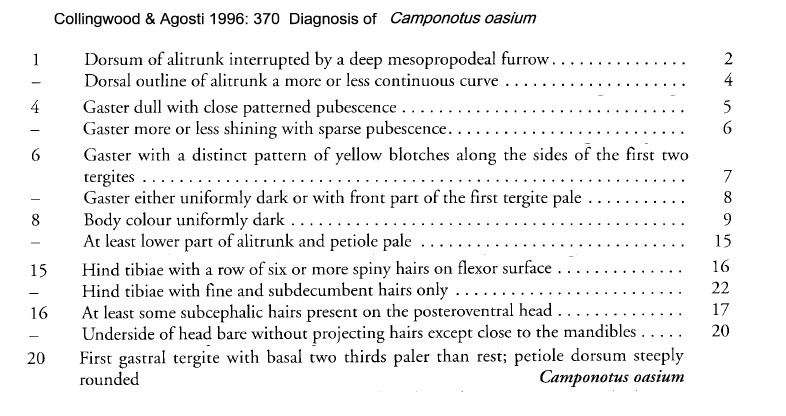Camponotus (Tanaemyrmex) oasium Forel
  Type location North
Africa oases (Camponotus rubripes r C. oasium n.
stirps, Forel, 1890a: lxv, major & minor workers & queen;
Forel, 1902a:
158, male, record no description; revived status as species
Collingwood, 1961a: 75) - queen shown below, no images of workers on Antweb (March 2019) Type location North
Africa oases (Camponotus rubripes r C. oasium n.
stirps, Forel, 1890a: lxv, major & minor workers & queen;
Forel, 1902a:
158, male, record no description; revived status as species
Collingwood, 1961a: 75) - queen shown below, no images of workers on Antweb (March 2019)
|
The type location is unclear but Forel (1886f) has the
Oasis de Bahrych as the first site on his list and later (1890a) wrote
of the ant of African oases.
In THE NATURALIST. ILLUSTRATIVE OF THE ANIMAL,
VEGETABLE, AND MINERAL KINGDOMS. WITH HIGHLY-FINISHED COLOURED
ENGRAVINGS AND WOOD CUTS - CONDUCTED BY B. MAUND, F.L.S., and W. HOLL,
F.G.S. VOL. I. LONDON: R. GROOMBRIDGE, PATERNOSTER ROW. M.DCCC.XXXVII. http://www.archive.org/stream/naturalistmaundh12lond/naturalistmaundh12lond_djvu.txt
There is a short paragraph -
"EXTRACTS FROM FOREIGN SCIENTIFIC JOURNALS. 1. — Mr. M. A. Lefebvre, in
a memoir contributed to the Entomological Society of France, mentions
having observed, while travelling in various parts of Egypt,
particularly in an excursion to the Oasis of Bahrych, an orthopterous
insect, which lives in the sands perfectly destitute of vegetation. He
examined several species, each differently coloured according to the
nature of the soil, which they so exactly resembled that it was
difficult to perceive them. What, therefore, is the nourishment of
animals like these, organized to exist upon living prey? They are found
in localities in which no herbivorous insect could exist, and Mr.
Lefebvre has never discovered the slightest vestige of vegetable or
animal matter with them. On the other hand, their elytrae and wings,
being ill adapted to flight, prevent the idea of their migrating like
Crickets. Are they, then, reduced to subsist upon the prey conveyed to
them occasionally by the winds? or do they live by devouring each other
? These are the questions which he has not been able to resolve,
notwithstanding his most patient and minute observations of this
singular insect. He has named it Eremiaphiles, from its peculiar
habitat : some species have already been figured in the great work on
Egypt, but without descriptions. Lefebvre has added several others, one
particularly remarkable in the articulations of the tarsi, which are
four in number on the anterior feet, and three on the two other pairs.
This fact is extremely important, and offers a new objection to the
classification of entomology by the tarsi, which has also been shaken
by several analagous facts, and must ultimately be abandoned,
notwithstanding its convenience. The above observations have induced
Lefebvre to constitute of this species a new genus, which other general
characters tend to induce. We regret extremely that we are not, at this
moment, able to give a more detailed description of this extraordinary
paradox in entomology."
|
 The poverty of
Forel's descriptions make it difficult to
know if the specimens below actually are C. oasium, not least
because Forel stated it was smaller than a minor of C. maculatus.
However, the size range he gave was TL 7-16 mm and this within that
range. Camponotus
maculatus was given a size range of 8-16 mm by Mayr (1862).
Specimens of maculatus I have seen fit that range.
Additionally, Forel wrote "les (workers) minor sont plus claire que les
(workers) major". Resolution requires major workers. The poverty of
Forel's descriptions make it difficult to
know if the specimens below actually are C. oasium, not least
because Forel stated it was smaller than a minor of C. maculatus.
However, the size range he gave was TL 7-16 mm and this within that
range. Camponotus
maculatus was given a size range of 8-16 mm by Mayr (1862).
Specimens of maculatus I have seen fit that range.
Additionally, Forel wrote "les (workers) minor sont plus claire que les
(workers) major". Resolution requires major workers.
Distinctive features of these minors are the near
rectangular anterior margin of the clypeus, bearing a fringe of strong
setae; the longitudinal flat or medianly impressed area of the dorsal
propodeum; the petiole profile with a convex anterior and vertical flat
posterior; a line of short setae on the ventral face of the hind tarsi.
The angular propodeum would place the species in the pompeius-group.
This appears to meet the criterion of Collingwood &
Agosti (1996: 370) in their key to species from Saudi Arabia (extracted
right).
|